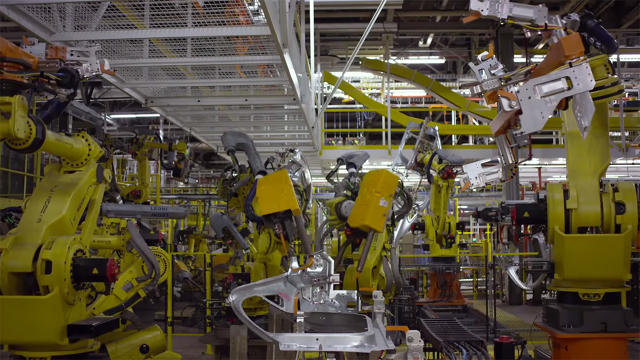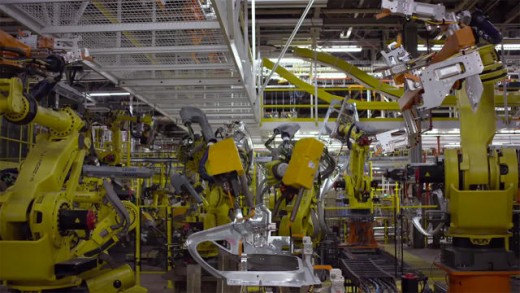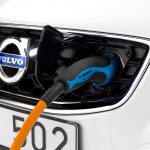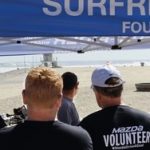Ford Throws Open Its Secret Bunker For A New Doc About The Making Of A Mustang
Director David Gelb talks about making the documentary A Faster Horse, creative control on a brand-backed film, and what he learned from engineer David Pericak.
Be sure to check the gallery above for a look at Mustang design over the course of 50 years.
Director David Gelb, best known for the 2011 documentary Jiro Dreams of Sushi, was intrigued when producers Nigel Sinclair and Glen Zipper asked him if he was interested in making a film tied to the 50th anniversary of the Ford Mustang. “It’s an indelible part of pop culture,” Gelb says of the iconic car, “and everyone has their own Mustang story.”
Including Gelb. A native of New York City, he recalls his dad taking him on business trips to Los Angeles when he was a kid and renting a Mustang GT convertible. “He would always make a big deal about it being a GT, and I remember sitting in the passenger seat feeling so cool zooming around Los Angeles in this car,” Gelb reflects, adding, “There’s no other car that has ever made an impression on me like that.”
Despite his affection for the Mustang, Gelb had concerns about making a movie about the car. That’s because the idea to shoot a film originated with Ford, and the company was fully funding the project. Like any director, Gelb worried executives at the automaker would demand creative control, something he wasn’t willing to give up.
But they had no such demand and were willing to place their trust in a documentarian devoted to making a great film rather than a slick piece of Branded Content. In fact, Gelb was given free reign to explore anything he wanted in the world of Mustang and complete creative control of the film. He ultimately made the documentary A Faster Horse, which debuted at the 2015 Tribeca Film Festival and is now in search of a distributor.
The documentary chronicles the development of the 50th anniversary edition of the Mustang, with the director using an all-access pass to go behind closed doors—and into Ford’s underground bunker—during the top-secret process, focusing his attention on David Pericak, the chief engineer who leads the effort.
It’s a prestigious post, but the pressure on Pericak and the designers and engineers working with him is intense—there are deadlines to meet and problems to be solved, including a last-minute issue with a vibrating steering wheel, and if drivers aren’t eager to get behind the wheel of the latest incarnation of the muscle car, thousands of workers at Ford’s Flat Rock Assembly Plant in Flat Rock, Michigan, will be out of work.
Here, Gelb, whose credits also include the 2015 horror film The Lazarus Effect and the docuseries Chef’s Table, now on Netflix, talks to Co.Create about the challenges he faced making A Faster Horse and what he learned from observing and interviewing Pericak.
Co.Create: There are many different ways you could have told this story. Why did you decide to focus on the experiences of the chief engineer?
Gelb: The biggest challenge when you’re doing a documentary about a thing or about a subject is you really need to find a character through which the audience can experience the story, whose perspective takes us through.
I went to Ford headquarters, and I met with a bunch of the engineers, and they took me down to the secret bunker where the new Mustangs are designed, and I was really drawn in by Dave Pericak, and I knew that he would be our main character. I was looking at Dave, and I thought, wow, he’s the chief engineer of this car, he’s a diehard Mustang fan, he proposed to his wife in a Mustang, he has a billion-dollar project on his shoulders, he has to live up to the legacy of the vehicle, and he also has to live up to the expectations of the legions of fans out there.
The equivalent in the film world would be like making the new Star Wars movie—that’s how important Mustang is in car culture, and so I thought, let’s make a film about this guy dealing with all these pressures and trying to get this project done on time.

The film also goes back in time and details legendary car executive Lee Iacocca’s role in the origin of the Mustang. It’s an interesting story given that he went rogue with a group of employees and worked on developing the car in secret before telling Henry Ford II about it.
Lee Iacocca’s story is a great story just on its own merit because Lee Iacocca just through his own force of will and vision managed to convince a car company that was pretty skittish about creating a new vehicle to do an all-new car.
Ford was reeling from the disaster that was the Edsel, a vehicle that Henry Ford II had named after his father that was incredibly costly to develop and was a big botch, a big failure in the industry, and so they were skittish. They didn’t necessarily want to make a new car, and Lee Iacocca kind of just made it happen.
He developed the Mustang secretly, and he didn’t really have any market research. He believed that the baby boomers who were just reaching driving age wanted an aspirational vehicle that they could actually afford, and he just made it happen.
There are parallels between Lee Iacocca and Dave Pericak that I kind of wanted to accentuate. In the same way, Dave is trying to push his vision through. So they’re both great leaders and visionaries.
Are you drawn to perfectionists? Your first feature-length documentary, Jiro Dreams of Sushi, was all about sushi master Jiro Ono, who has devoted his life to making the best sushi, and, now, the main character in this film, David Pericak, is also a perfectionist, dedicated to making the best Mustang.
Yeah, for sure. I’m definitely drawn to making films about passionate characters who are obsessed with what they do and who are visionaries. They have a vision, and they refuse to take no for an answer, and they find a way to make it happen. I just think that’s so inspiring.
Building the Mustang is a very different kind of creative endeavor than what we saw in Jiro Dreams of Sushi because it’s a massive team, and while with Jiro Dreams of Sushi, price is no object [one meal at Jiro Ono’s sushi restaurant costs nearly $400], part of the challenge Pericak has is making a beautiful car that people aspire to own but that is still affordable.

Early on in the film, Pericak turns to you and tells you his colleagues are not merely uncomfortable by the presence of cameras—they are freaked out. Did you go into this film knowing that it would probably take some time for the people involved in this secretive project to get used to having you around documenting the good and the bad?
Oh, sure. We had the mandate from the beginning from Ford that they were going to open the doors and let us shoot anything that we wanted. But practically executing that was another matter because Ford is a huge corporation, and things are very, very secretive in the car industry because of the fierce competition, and even with that mandate, they just couldn’t get used to the fact that I was walking into rooms where there were giant signs on the wall that said no filming of any kind with a camera.
These are places where they take away your cell phone when you come in just to make sure that you can’t take any pictures of the car. It’s that serious, and so the guys were freaked out by it at first, but the way that we made it work was through Dave.
Because Dave is the boss, and he’s such a great leader, and his team members trust him so much, if he says, “These guys are filming and they’re going to make us look good, then they just were like, ‘Alright, if you say so.’”
But there were definitely some funny moments where we’re filming some of these meetings, where there are real problems that are being addressed, and we’re showing the worst in all the entire creative process—there are certainly moments where they all kind of like look at each other, and then look at the camera, and Dave says, “Yeah, go ahead.” And they just kind of shrug, and they lay it all out on the table.
There are plenty of great visuals in the film of the new Mustang as well as gorgeous Mustangs from throughout the years, but sound is also a major part of A Faster Horse. There is a moment just a few minutes into the film when we hear all kinds of Mustangs revving their engines. It’s like a symphony of car sounds. Did you make a special effort regarding sound for this film, knowing that car buffs would be looking and listening, too?
Totally. One of the first things that people think about when they think about driving a Mustang is the roar of the engine, and we talk a little bit in the film about how hard the engineers work to make sure that the signature sound of the Mustang engine is present when you’re driving the new car because there’s a real kind of audio signature to that.
Our editor Isaac Hagy is brilliant with sound and using sounds in his edits, but then we also had the opportunity to take it a step further with our sound mixer. Mark Stoeckinger is our supervising sound editor, and he’s an industry legend. [Stoeckinger’s credits include the films Iron Man 3, Prometheus and J.J. Abram’s Star Trek.]
This is a guy who does major, major Hollywood movies, and we would never be able to afford him if it weren’t for the fact that he is just obsessed with Mustangs, and so he took this on as a pet project and really made the sound in the 5.1 surround just explode out of the screen.
He also took very careful care to make sure that every engine sound that you see on screen is accurate to that model of Mustang, which takes an incredible amount of detail and extra sound recording. We rented cars, and we found cars, and we recorded them. We also found old recordings of the original engines. The sound is incredibly accurate. I knew that Mustang fans watching this film would be sticklers for those types of details.

Are there parallels between making cars and making movies? Did you learn anything from being around the people at Ford while making A Faster Horse that will impact how you make movies in the future?
Sure. I learned lessons in leadership from Dave Pericak. He was giving me advice on leadership and how to help team members reach their fullest potential.
There’s a great scene in the movie—we call it the dragon slaying scene—where he talks about how he encourages his team members to take risks, and they take risks knowing that Dave will be there to help pick up the pieces if something goes wrong, and so he says that they’re out there playing dragon, and they have the courage to do that because they know that if that one dragon becomes unruly, you as the leader are there to help finish it off.
If people are afraid to fail, they’re going to be timid, and they’re not going to do the best work that they can because they’re afraid of getting in trouble. So that kind of modern style of leadership I really admire in Dave, and we worked the same way with all our departments [when we were making A Faster Horse].
Fast Company , Read Full Story
(210)














